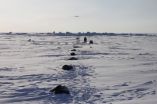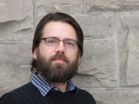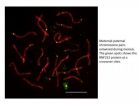(Press-News.org) New research using combined records of ice measurements from NASA's Ice, Cloud and Land Elevation Satellite (ICESat), the European Space Agency's CryoSat-2 satellite, airborne surveys and ocean-based sensors shows Arctic sea ice volume declined 36 percent in the autumn and 9 percent in the winter over the last decade. The work builds on previous studies using submarine and NASA satellite data and confirms computer model estimates that showed ice volume decreases over the last decade, and builds a foundation for a multi-decadal record of sea ice volume changes.
In a report published online recently in the journal Geophysical Research Letters, a large international collaboration of scientists outlined their work to calculate Arctic sea ice volume. The satellite measurements were verified using data from NASA's Operation IceBridge, ocean-based sensors and a European airborne science expedition. This was compared with the earlier sea ice volume record from NASA's ICESat, which reached the end of its lifespan in 2009.
The researchers found that from 2003 to 2008, autumn volumes of ice averaged 11,900 cubic kilometers. But from 2010 to 2012, the average volume had dropped to 7,600 cubic kilometers – a decline of 4,300 cubic kilometers. The average ice volume in the winter from 2003 to 2008 was 16,300 cubic kilometers, dropping to 14,800 cubic kilometers between 2010 and 2012 – a difference of 1,500 cubic kilometers.
The study, funded by the United Kingdom's National Environmental Research Council ESA, the German Aerospace Center, Alberta Ingenuity, NASA, the Office of Naval Research and the National Science Foundation and led by Professor Seymour Laxon of University College London, marks the first ice volume estimates from CryoSat 2, which was launched in 2010. "It's an important achievement and milestone for CryoSat-2," said co-author Ron Kwok at NASA's Jet Propulsion Laboratory in Pasadena, Calif.
VIDEO:
Animation showing changes in monthly Arctic sea ice volume using data from ESA's CryoSat-2 (red dots) and estimates from the Pan-Arctic Ice Ocean Modeling and Assimilation System (PIOMAS) (solid line)...
Click here for more information.
Combining the Ingredients
Although CryoSat-2 data show a decrease in ice volume from 2010 to 2012, two years is not a long enough time span to determine a trend. This is where NASA's data and scientists come in. Data from ICESat and IceBridge are freely available, but combining measurements from different sources can be challenging. Kwok said researchers spent months working out how to compare the datasets and make sure they were compatible enough to compare trends "We participated as collaborators to help interpret results from the datasets we're familiar with," said scientist Sinead Farrell at NASA's Goddard Space Flight Center in Greenbelt, Md.
CryoSat-2 and ICESat both measure sea ice freeboard, that is, the amount of ice floating above the ocean's surface. Researchers use freeboard to calculate ice thickness. This thickness measurement is then combined with ice area to come up with a figure for volume. The two satellites used different methods for measuring freeboard however. ICESat used a laser altimeter, which bounces a laser off the snow covering the sea ice, while CryoSat-2 uses a radar instrument that measures surface elevation closer to the ice surface. These instruments have a different view of the surface, but researchers found they gave comparable measurements.
Check and Double Check
Comparing the two datasets and ensuring their quality called for additional data. The two satellites do not cover overlapping time spans, so researchers used measurements from upward-looking sonar (ULS) moorings under the ocean's surface, located north of Alaska. These instruments, operated by the Woods Hole Oceanographic Institution's Beaufort Gyre Exploration Project, provide a continuous record of ice draft – thickness of ice below the ocean's surface – in parts of the Beaufort Sea from 2003 to the present day. Thickness measurements from these ULS moorings were comparable to ICESat and CryoSat-2 data throughout both missions' time spans. "ULS ice draft since 2003 served as the common data set for cross comparison of the ICESat and CryoSat-2 measurements," said Kwok.
Researchers took extra care to verify CryoSat-2's data as it is a new satellite with a new instrument. In addition to the ULS data, CryoSat-2 measurements were also verified by two airborne science campaigns: flights by an aircraft operated by the Alfred Wegener Institute for Polar and Marine Research in Bremerhaven, Germany; and Operation IceBridge, a NASA mission tasked with monitoring changes in polar ice to bridge the gap in measurements between ICESat and its replacement, ICESat-2, scheduled to launch in 2016. During the 2011 and 2012 Arctic campaigns, the IceBridge team coordinated closely with ESA's CryoVEx program to verify CryoSat-2 data. "IceBridge was used as a validation tool to understand thickness measurements from CryoSat-2," said scientist Nathan Kurtz at NASA Goddard.
The Road Ahead
After months of work, researchers had assembled a multi-year dataset that they could compare to sea ice volume predictions from the Pan-Arctic Ice-Ocean Modeling and Assimilation System (PIOMAS). Because of the short time span of previous satellite studies, researchers have used models like PIOMAS to simulate changes in sea ice volume. The study's observations show a larger autumn ice volume decrease than predicted, while changes in the winter are smaller than in the model simulation. "It's important to know because changes in volume indicate changes in heat exchange between the ice, ocean and atmosphere," said Kurtz.
This study and the knowledge that the datasets are compatible also serve to lay groundwork for ICESat-2. CryoSat-2 gathers data over more of the Arctic than ICESat did by reaching 88 degrees north (ICESat reached 86 degrees). ICESat-2 will orbit Earth at the same angle as CryoSat-2 and will therefore survey the same amount of the Arctic.
CryoSat-2 is funded through 2017 but will likely operate until the end of the decade, giving overlapping coverage with ICESat-2. This potential overlap greatly improves the prospects for improved knowledge of Arctic sea ice volume. "The hope is that we'll be able to create a multi-decadal record using ICESat, CryoSat-2 and ICESat-2," said Kwok.
INFORMATION:
NASA scientists part of Arctic Sea ice study
2013-02-14
ELSE PRESS RELEASES FROM THIS DATE:
Resignation of Pope Benedict XVI demands a close look at rules of modern papal election
2013-02-14
New Rochelle, NY, February 13, 2013—When Pope Benedict XVI ends his reign at the end of February he will be the first pope to do so before his death in nearly 600 years. He shocked the Catholic Church by announcing his resignation and set in place a centuries-old process to select his successor. The fascinating Conclaves system for electing a new pope, which has been in place since the late 1200s is described in "Creating the Rules of the Modern Papal Election," published in Election Law Journal, from Mary Ann Liebert, Inc., publishers. The article is available on the Election ...
Why there are bad learners: EEG activity predicts learning success
2013-02-14
The reason why some people are worse at learning than others has been revealed by a research team from Berlin, Bochum, and Leipzig, operating within the framework of the Germany-wide network "Bernstein Focus State Dependencies of Learning". They have discovered that the main problem is not that learning processes are inefficient per se, but that the brain insufficiently processes the information to be learned. The scientists trained the subjects' sense of touch to be more sensitive. In subjects who responded well to the training, the EEG revealed characteristic changes ...
Genetic study pursues elusive goal: How many humpbacks existed before whaling?
2013-02-14
Scientists from Stanford University, the Wildlife Conservation Society, the American Museum of Natural History, and other organizations are closing in on the answer to an important conservation question: how many humpback whales once existed in the North Atlantic?
Building on previous genetic analyses to estimate the pre-whaling population of North Atlantic humpback whales, the research team has found that humpbacks used to exist in numbers of more than 100,000 individuals. The new, more accurate estimate is lower than previously calculated but still two to three times ...
Robots with lift
2013-02-14
They can already stand, walk, wriggle under obstacles, and change colors. Now researchers are adding a new skill to the soft robot arsenal: jumping.
Using small explosions produced by a mix of methane and oxygen, researchers at Harvard have designed a soft robot that can leap as much as a foot in the air. That ability to jump could one day prove critical in allowing the robots to avoid obstacles during search and rescue operations. The research is described in a Feb. 6 paper in the international edition of Angewandte Chemie.
"Initially, our soft robot systems used pneumatic ...
Study supports regulation of hospitals
2013-02-14
EAST LANSING, Mich. — Hospital beds tend to get used simply because they're available – not necessarily because they're needed, according to a first-of-its-kind study that supports continued regulation of new hospitals.
Michigan State University researchers examined all 1.1 million admissions at Michigan's 169 acute-care hospitals in 2010 and found a strong correlation between bed availability and use, even when accounting for myriad factors that may lead to hospitalization. These factors include nature of the ailment, health insurance coverage, access to primary care ...
Clues to chromosome crossovers
2013-02-14
Neil Hunter's laboratory in the UC Davis College of Biological Sciences has placed another piece in the puzzle of how sexual reproduction shuffles genes while making sure sperm and eggs get the right number of chromosomes.
The basis of sexual reproduction is that a fertilized egg gets half its chromosomes from each parent — sperm and eggs each contributing one partner in each pair of chromosomes. We humans have 23 pairs of 46 chromosomes: so our sperm or eggs have 23 chromosomes each.
Before we get to the sex part, though, those sperm and eggs have to be formed from ...
Preventing obesity transmission during pregnancy
2013-02-14
A much neglected part of the obesity epidemic is that it has resulted in more overweight/obese women before and during pregnancy. Their offspring also tend to have higher birth weights and more body fat, and carry an increased risk of obesity and chronic diseases later in life. However, the nutritional factors and mechanisms involved pre and during pregnancy that may influence child obesity remain uncertain. A recent publication by ILSI Europe identifies and discusses key contributing factors leading to obesity.
In an article recently published in Annals of Nutrition and ...
Probiotic-derived treatment offers new hope for premature babies
2013-02-14
BETHESDA, Md. (Feb. 13, 2013)—"Good" bacteria that live in our intestines have been linked with a variety of health benefits, from fighting disease to preventing obesity. In a new study, Kriston Ganguli of Massachusetts General Hospital for Children and Harvard Medical School and her colleagues have discovered another advantage to these friendly microscopic tenants: Chemicals secreted by good bacteria that typically live in the intestines of babies could reduce the frequency and severity of a common and often-lethal disease of premature infants.
This disease, known as ...
Marsh plants actively engineer their landscape
2013-02-14
DURHAM, NC -- Marsh plants, far from being passive wallflowers, are "secret gardeners" that actively engineer their landscape to increase their species' odds of survival, says a team of scientists from Duke University and the University of Padova in Italy.
Scientists have long believed that the distribution of plants within a marsh is a passive adaption in which species grow at different elevations because that's where conditions like soil aeration and salinity best meet their needs.
But this team found intertidal marsh plants in Italy's famed Venetian lagoon were ...
Cellular renewal process may underlie benefits of omega fatty acids
2013-02-14
A search for genes that change their levels of expression in response to nutrient deprivation has uncovered potential clues to the mechanism underlying the health benefits of omega fatty acids. In the Feb. 15 issue of Genes & Development, Massachusetts General Hospital (MGH) researchers describe finding that feeding omega-6 fatty acids to C. elegans roundworms or adding them to cultured human cells activates a cellular renewal process called autophagy, which may be deficient in several important diseases of aging. A process by which defective or worn-out cellular components ...





